Quck answer
Here are 10 venomous creatures you might encounter in your backyard:
1. Black Widow Spider – Recognized by the red hourglass shape on its abdomen.
2. Brown Recluse Spider – Identified by its violin-shaped marking on its back.
3. Copperhead Snake – Known for its copper-colored head and hourglass-shaped markings.
4. Eastern Diamondback Rattlesnake – Identified by its diamond-shaped markings.
5. Gila Monster – A large, venomous lizard found in the southwestern United States and Mexico.
6. Poison Dart Frog – A colorful frog found in Central and South America.
7. Scorpion – Identified by its pincers and stinger.
8. Tarantula – A large, hairy spider found in warmer climates.
9. Water Moccasin – Also known as a cottonmouth, this snake is found in the southeastern United States.
10. Yellow Jacket – A type of wasp with yellow and black stripes.
Animal Facts
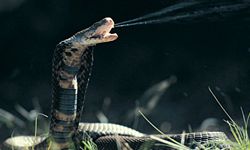
It is possible that some venomous animals live in your backyard, even if it’s not a Mozambique Spitting Cobra.
Venomous creatures, such as snakes, spiders, and scorpions are often seen as villains of the animal kingdom due to their frightening appearance and deadly toxins. However, their danger to humans is often exaggerated. Only 10% of the world’s snakes are venomous and in the United States, you are nine times more likely to be struck by lightning than to be killed by a venomous snake. Although about 8,000 people get venomous snakebites each year in the United States, only about a dozen die from them.
The reason why people are so scared of these animals is that snakes, in particular, look very different from humans, with no arms, legs, or eyelids. This anatomy and their stare can be unnerving. Moreover, Judeo-Christian beliefs that connect snakes to Satan in the Garden of Eden contribute to people’s unease about them.
Depending on where you live, you may encounter one of these venomous creatures in your backyard. The best advice is to leave them alone as most people are bitten when they try to kill or pick up the animal. Venomous creatures do not want to waste their venom on something they cannot eat, and it takes a lot of energy to produce venom. Therefore, unless their lives are in immediate danger, they would rather hide or run away.
In this article, we will learn about ten dangerous creatures that may be in your backyard and how to avoid them safely.
10: Death Stalking Scorpion
This venomous scorpion, which is found in Africa, Asia, and the Middle East, has a scary name and is usually found hiding under rocks or inside small burrows in dry and desert areas. The scorpion is 4 to 5 inches (10.2 to 12.7 centimeters) long and can catch its prey, such as crickets and mealworms, using only its claws. However, if it needs more firepower, it can use its tail to deliver highly toxic venom quickly.
This scorpion kills several people every year, especially children. Its neurotoxin moves through the body rapidly, causing extreme pain, fever, convulsions, paralysis, and sometimes coma and death. An antivenom does exist, but it’s essential to seek immediate medical attention if you are stung.
Although this animal’s name is provocative and may tempt poorly trained animal collectors, it is crucial to leave it to professionals. Pet stores often import many species of scorpions from around the world, often without knowing how dangerous they might be.
Interestingly, this scorpion’s highly toxic and complex venom could be a possible treatment for brain cancer. Clinical trials are already underway on patients with malignant glioma, the cancer that killed Sen. Edward Kennedy.
The lesson is that less threatening names do not always mean harmless stings.
9: Yellow Jacket
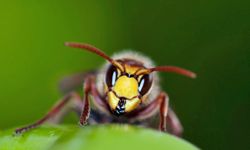
Despite their small size, yellow jackets have a venomous sting that can cause pain. These wasps are attracted to sweet smells, meat, and fish odors, making them common at picnics and outdoor events. Yellow jackets live in temperate areas across North America and can be found in attics, walls, and even abandoned animal burrows. They are social insects and live in nests with hundreds or thousands of individuals. Female yellow jackets have stingers attached to their abdomen, which can sting multiple times. It’s best to avoid swatting or flailing at them, as this will only make them more aggressive. The CDC reports that insect bites cause 90 to 100 deaths each year due to severe allergic reactions. However, yellow jackets are beneficial to have around because they eat flies and mosquitoes.
8: Paper Wasp
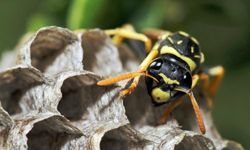
Paper wasps are named for their easily recognizable honeycomb nests, which can be found in many locations such as under building overhangs, metal gutters, and outdoor grills. These wasps have long, thin, hairless bodies and are usually reddish-brown with yellow markings. Mature nests house 20 to 30 adults who forage during the day. Paper wasps are usually not aggressive towards humans and will only sting if they feel threatened or are touched. Female paper wasps can sting multiple times, while males are harmless. It’s important to be aware of these insects during the summer, as they are beneficial to have around because they eat caterpillars, flies, and beetle larvae. The queen stops laying eggs by late summer, and the colony begins to die off. Paper wasps build new nests each year, often in the same location as previous successful nests.
7: Bullet Ant

Bullet ants are known for their extremely painful sting, which is as piercing as a bullet. They are found in Central and South America and are also known as 24-hour ants because of the belief that a person stung by one would only have 24 hours to live. These ants are aggressive and have a powerful sting that can cause intense pain. However, their sting is not fatal.
The bullet ant, known for its ferocity, causes excruciating pain that can last for three to five hours. The pain is accompanied by trembling, perspiration, nausea, and the inability to use the injured arm or leg. While some use antihistamines and ice packs to relieve the pain, others self-medicate with alcohol. Interestingly, some South American tribes intentionally inflict bites from these inch-long, reddish-black ants on teenagers during manhood rituals. The Brazilian Wandering Spider is another venomous creature found in Brazil that can be deadly. Its venom causes priapism, a painful and prolonged erection in males. The venom is currently being studied as a possible treatment for erectile dysfunction. The Black Widow Spider, found in warm regions around the world, has a nasty reputation for its venomous bite that can cause cramps, difficulty breathing, nausea, and even death. Fortunately, only the female bites defensively when touched or disturbed.
There is a popular belief that female black widows devour their male counterparts, but this is rare and usually only happens in captivity when the male cannot escape. Females are generally twice the size of males.
It is best to keep a safe distance from spider webs and assume that a spider is present. Black widow spiders tend to stay put once they have built their web and are not very agile when they are forced to leave it.
4: King Cobra Snake

The king cobra’s hood is created by the action of muscles and ribs in its neck, which adds to its legendary status.
Hemera/Thinkstock
The king cobra is the largest venomous snake, reaching up to 18 feet (5.5 meters) in length, and is incredibly fast when it strikes. It is found in India, China, and Southeast Asia in areas like bamboo forests, mangrove swamps, tea plantations, and forests.
Their neck hood, created by the action of muscles and ribs, is a signature feature that makes them look menacing and is used as a scare tactic against potential predators. When threatened, the king cobra will stand up, spread out its hood, and hiss loudly. Their fangs are not retractable like vipers and are about 0.5 inches (1.3 centimeters) long. The venom is a neurotoxin that acts on the nervous system and can stop a victim’s breathing and heartbeat. King cobras can climb trees and are excellent swimmers, making them a formidable predator.
Their size and venom production can be lethal, even to an elephant, and they are responsible for about five human deaths per year. However, they have one natural enemy, the mongoose, which can bite them on the back of the neck.
Keep reading to learn about a color scheme that everyone should know about.
3: Coral Snake
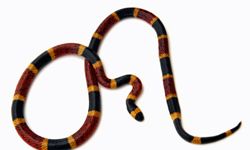
The coral snake looks similar to the non-venomous king snake, which gives the king snake an advantage.
iStockphoto/Thinkstock
The coral snake is often confused with harmless snakes like the non-venomous king snake. To differentiate them, people use the mnemonic rhyme “Red to yellow will kill a fellow, red to black is a friend of Jack.”
Coral snakes are small, usually only 20 to 30 inches (50.8 to 76.2 centimeters) long, and can be found hiding in piles of leaves, loose earth, or even buried in the ground. Their bites can be serious, and victims should seek medical attention immediately. Unlike pit vipers, coral snakes have short teeth, not long fangs, making their venom delivery less efficient.
Coral snakes are related to Old World cobras and are found in parts of the US, including Florida, North Carolina, and Texas, as well as parts of Mexico. They prefer to live in scrub palms near wetlands and can climb trees.
2: Copperhead Snake
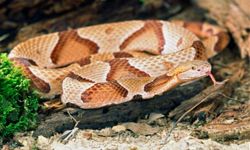
The copperhead snake is highly adaptable to living near humans, even in urban areas.
Design Pics/Valueline/Thinkstock
Copperheads are able to thrive in a range of environments, from forests and swamps to mountains and suburbs. They are medium-sized snakes, measuring between 2 and 4 feet (0.6 to 1.2 meters) in length, and are experts at blending in with their surroundings. Their copper and bronze coloring allows them to easily camouflage themselves in leaves, logs, and tree limbs.
Although their colors may vary, copperheads typically have an hourglass-like banding pattern on their bodies. They are not naturally aggressive, but stepping on one can result in a bite.
Copperheads are commonly found throughout much of the central United States, from Mexico to New England, and can be found in forests, rocky hillsides, and even suburban and urban areas. In some cases, they may even live alongside timber rattlesnakes.
As with many snake species, there are several myths surrounding copperheads, such as the belief that they emit the scent of cucumbers near humans. The reality is that many snakes release a musky odor when frightened, which can attract predators.
1: Rattlesnake

Rattlesnakes are pit vipers that can be dangerous if provoked, but will typically avoid humans if possible.
iStockphoto/Thinkstock
Rattlesnakes are known for their coiled, powerful bodies, rattling tails, and forked tongues. They strike fear in other creatures, including humans, but are generally timid and will try to avoid confrontation if possible. However, they can be deadly if provoked or stepped on.
These snakes can be found in a variety of environments, including backyards, mountains, prairies, deserts, and even beaches.
Rattlesnakes are pit vipers, and use their loreal pit to detect heat from prey or predators. When they strike, they can inject venom through their hollow fangs. They are the largest venomous snakes found in the United States, with some species, such as the Western Diamondback, measuring over 7 feet (2.1 meters) long.
Even baby rattlesnakes are potent, possessing both fangs and venom at birth. They are also highly resilient, able to survive for months without eating and living for over 20 years.
When in areas where rattlesnakes may be present, it’s important to be cautious and avoid sitting or reaching into brush or leaves where they may be hiding. A group of rattlesnakes is known as a rhumba, and should be avoided at all costs.
Additional Information
Related Articles
- How Snakes Function
- How Wasps Function
- How Bees Function
- The Difference Between Bees and Wasps
- How Spiders Work
- How Pain Works
- Are Humans Programmed to Survive?
- If I Remove the Venom from a Snake Bite, Will I Survive?
More Useful Links
- Wasp and Bee Control
- Snake Bites
Sources
- Andrews, Kimberly, and Willson, J.D. “Copperheads.” Savannah River Ecology Laboratory. (Nov. 15, 2011) http://www.uga.edu/srelherp/snakes/agkcon.htm
- Arizona Game and Fish Dept. “Rattlesnake Facts.” (Nov. 15, 2011) http://www.azgfd.gov/w_c/arizona-rattlesnakes.shtml
- Barnett, Parker. Wildlife Biologist. Personal Interview Conducted Sept. 20, 2010.
- Florida Museum of Natural History “Online Guide to Florida Snakes.” (Nov. 15, 2011) http://www.flmnh.ufl.edu/herpetology/fl-guide/onlineguide.htm
- Lobos, Ignacio. “Buck Rogers and the Amazing Death Stalker Scorpion.” Hutchinson Cancer Research Center (Nov. 15, 2011) http://www.fhcrc.org/about/pubs/quest/articles/2007/12/scorpion.html
- Johnson, Steve. “Frequently Asked Questions About Venomous Snakes.” 2007. (Nov. 15, 2011) http://ufwildlife.ifas.ufl.edu/venomous_snake_faqs.shtml
- Journal of the Federation of American Societies for Experimental Biology “Toxin Tx2-6 from the Spider “Phoneutria Nigriventer” Improves the Impaired Erectile Function in DOCA-Salt Hypertensive Rats.” 2007. (Nov. 15, 2011) http://www.fasebj.org/cgi/content/meeting_abstract/21/6/A881-c
- Morgan, Randy. Curator, Invertebrates, Reptiles & Amphibians. Cincinnati Zoo and Botanical Garden. Personal Interview Conducted Sept. 21, 2010.
- Morgan, Randy. “Giant Tropical Bullet Ant.” (Nov. 15, 2011) http://www.sasionline.org/antsfiles/pages/bullet/bulletbio.html
- National Institutes of Health Medline Plus “Snake Bites.” Jan. 13, 2010. (Nov. 15, 2011) http://www.nlm.nih.gov/medlineplus/ency/article/000031.htm
- North Carolina State University “North Carolina Venomous Snakes.” (Nov. 15, 2011) http://www.ces.ncsu.edu/gaston/Pests/reptiles/venomousnake.htm
- Philadelphia Zoo “Meet Our Animals.” (Nov. 15, 2011) http://www.philadelphiazoo.org/zoo/meet-our-animals/reptiles/lizards-and-snakes/king-cobra.htm
- Rein, Jan Ove. “Leiurus Quinquestriatus.” Norwegian University of Science and Technology. (Nov. 15, 2011) http://www.ntnu.no/ub/scorpion-files/l_quinquestriatus.php
- Saint Louis Zoo. “Bullet Ant.” (Nov. 15, 2011) http://www.stlzoo.org/animals/abouttheanimals/invertebrates/insects/antsbeeswasps/bulletant.htm
- San Diego Zoo. “Don’t Hate Me Because I’m Venomous.” 2011. (Nov. 15, 2011) http://www.sandiegozoo.org/animalbytes/t-cobra.html
- Sheils, Andrew L. “The Northern Copperhead.” Pennsylvania Fish and Boat Commission. (Nov. 15, 2011) http://www.fish.state.pa.us/copprhe.htm
- Shisk-Saling, Teresa. Veterinary Technician and Herpetologist, Texas A&M University College of Veterinary Science. Personal Interview Conducted Sept. 21, 2010.
- Jackman, John A. “Black Widow Spiders.” Texas A&M University. Aug. 10, 2001. (Nov. 15, 2011) http://insects.tamu.edu/extension/youth/bug/bug160.html
- Texas Agricultural Extension Service. “Spiders.” 2008. (Nov. 15, 2011) http://insects.tamu.edu/extension/bulletins/l-1787.html
- University of Massachusetts-Amherst. “Snake Mythology.” 2008. (Nov. 15, 2011) http://www.umass.edu/nrec/snake_pit/pages/myth.html
- U.S. Centers for Disease Control and Prevention. “Venomous Snakes.” (Nov. 15, 2011) http://www.cdc.gov/niosh/topics/snakes/
- U.S. Centers for Disease Control and Prevention. “Venomous Spiders.” (Nov. 15, 2011) http://www.cdc.gov/niosh/topics/spiders/
- Zurek, Ludek. “Spiders and Scorpions.” Kansas State University. July 2005. (Nov. 15, 2011) http://www.ksre.ksu.edu/library/entml2/mf771.pdf
FAQ
1. What are the 10 venomous creatures that can be found in my backyard?
The 10 venomous creatures that can be found in your backyard are: black widow spider, brown recluse spider, Arizona bark scorpion, yellow sac spider, funnel web spider, copperhead snake, coral snake, cottonmouth snake, timber rattlesnake, and eastern diamondback rattlesnake.
2. What are the symptoms of a black widow spider bite?
The symptoms of a black widow spider bite include: local pain and swelling, muscle cramps, abdominal pain, nausea, vomiting, respiratory difficulties, and high blood pressure. It is important to seek medical attention immediately if you suspect you have been bitten by a black widow spider.
3. How can I prevent a brown recluse spider bite?
To prevent a brown recluse spider bite, it is important to keep clutter and debris to a minimum in your backyard. Wear gloves and long sleeves when working in areas where brown recluse spiders may be present. If you suspect you have a brown recluse spider infestation, contact a pest control professional.
4. What should I do if I am stung by an Arizona bark scorpion?
If you are stung by an Arizona bark scorpion, seek medical attention immediately. Symptoms include: numbness and tingling, muscle spasms, respiratory difficulties, and convulsions. Apply a cold compress to the sting area to reduce swelling and pain.
5. How can I prevent a snake bite?
To prevent a snake bite, it is important to wear protective clothing, such as boots and long pants, when working in areas where snakes may be present. Keep your backyard free of clutter and debris, which can attract snakes. If you encounter a snake, back away slowly and do not try to approach or handle it.
6. What are the symptoms of a coral snake bite?
The symptoms of a coral snake bite include: local pain and swelling, muscle weakness, difficulty speaking, respiratory difficulties, and seizures. Seek medical attention immediately if you suspect you have been bitten by a coral snake.
7. How can I prevent a yellow sac spider bite?
To prevent a yellow sac spider bite, keep your backyard free of clutter and debris. Wear gloves and long sleeves when working in areas where yellow sac spiders may be present. If you suspect you have a yellow sac spider infestation, contact a pest control professional.
8. How can I identify a funnel web spider?
A funnel web spider is identified by its funnel-shaped web and stocky body. The spider is typically brown or gray in color and can range in size from small to medium. If you suspect you have a funnel web spider infestation, contact a pest control professional.





Leave a Reply